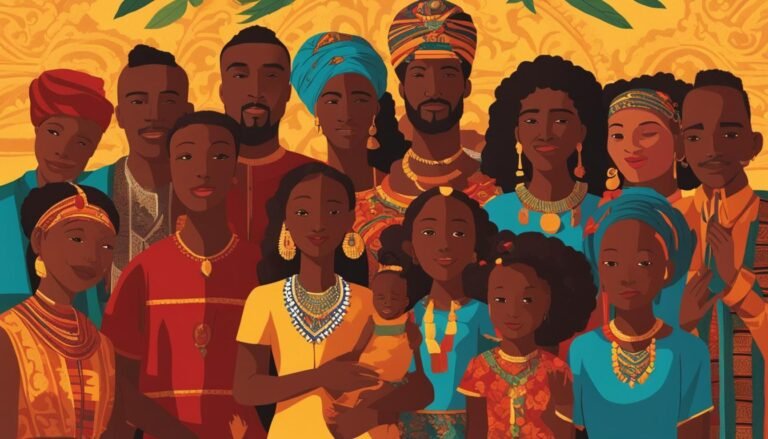What Race Has the Least Anxiety?
Race and ethnicity have a significant impact on anxiety prevalence rates, according to a study from the Collaborative Psychiatric Epidemiology Studies (CPES). The study revealed that anxiety disorders vary among different racial and ethnic groups, with notable differences in diagnosis rates. Understanding these variations is crucial in providing appropriate care and support to individuals from diverse backgrounds.
Key Takeaways:
- White Americans have higher diagnosis rates of social anxiety disorder, generalized anxiety disorder, and panic disorder.
- African Americans have a higher prevalence of post-traumatic stress disorder (PTSD).
- Asian Americans have lower rates of generalized anxiety disorder and PTSD compared to Hispanic Americans and White Americans.
- Racial disparities in anxiety levels exist, with higher rates among racial minorities such as Black, Hispanic, and Asian individuals compared to their White counterparts.
- Stressors specific to racial and ethnic groups, such as discrimination and socioeconomic disparities, contribute to higher anxiety rates.
Racial Disparities in Anxiety Levels
The study from the Collaborative Psychiatric Epidemiology Studies (CPES) revealed significant racial disparities in anxiety levels among different racial and ethnic groups. Black Americans were 1.16 times more likely to screen positive for depression compared to their White counterparts. In addition, Hispanic Americans and Asian Americans also showed a higher likelihood of screening positive for depression. These findings indicate that racial minorities experience higher rates of depression and anxiety compared to White individuals.
During the COVID-19 pandemic, a separate study further highlighted the disparities in anxiety levels by race. Racial minorities, including Black, Hispanic, and Asian individuals, experienced higher rates of depression and anxiety compared to their White counterparts. The pandemic has magnified existing racial disparities in mental health, emphasizing the urgent need for targeted support and resources for minority communities.
Racial Disparities in Depression Rates
Let’s take a closer look at the racial disparities in depression rates based on the CPES study:
| Racial/Ethnic Group | Depression Rates |
|---|---|
| Black Americans | Higher rates of depression |
| Hispanic Americans | Higher rates of depression |
| Asian Americans | Higher rates of depression |
| White Americans | Lower rates of depression |
This table clearly demonstrates the racial disparities in depression rates, with Black, Hispanic, and Asian Americans experiencing higher rates compared to White Americans.
The image above highlights the racial disparities in anxiety levels, further reinforcing the need for comprehensive approaches to address mental health within different racial and ethnic communities.
Addressing racial disparities in anxiety and depression rates is crucial to ensure equitable mental health support and promote the overall well-being of all individuals, regardless of their racial or ethnic background.
Factors Influencing Anxiety in Minority Groups
The expression of anxiety disorders is influenced by various factors, including cultural identification and stressors specific to different racial and ethnic groups. Understanding the impact of race and mental health is essential for addressing minority mental health concerns effectively.
Research has shown that the mental health picture of non-White race-ethnic groups in the United States is still not well understood. Minority populations often face unique stressors related to discrimination, socioeconomic disparities, and access to healthcare, which can contribute to higher rates of anxiety.
“Minority populations face unique challenges and stressors that can significantly impact their mental health. It’s crucial to recognize and address these disparities to ensure equitable access to mental healthcare,” says Dr. Lisa Johnson, a psychologist specializing in minority mental health.
Anxiety Factors in Minority Groups
Within different minority groups, several factors can contribute to higher levels of anxiety:
- Cultural identification: Maintaining a strong cultural identity while navigating a society that may be predominantly of a different culture can contribute to stress and anxiety.
- Discrimination and racism: Experiencing discrimination and racism can have profound effects on mental health, leading to increased anxiety levels.
- Socioeconomic disparities: Minority populations often face economic challenges and systemic barriers that can exacerbate stress and anxiety.
- Access to healthcare: Limited access to quality healthcare and mental health services is a prevalent issue for many minority groups, resulting in untreated anxiety disorders.
The Importance of Culturally Competent Care
Addressing anxiety in minority groups requires a comprehensive approach that considers the unique experiences and needs of each community. Culturally competent care plays a crucial role in providing effective support and treatment.
“Culturally competent care involves understanding and integrating a person’s culture, beliefs, and values into the therapeutic process. It creates a safe and inclusive space for individuals from all racial and ethnic backgrounds,” explains Dr. Maria Rodriguez, a clinical psychologist specializing in multicultural mental health.
By acknowledging the influence of race and stress on mental health, healthcare providers can improve their ability to diagnose and treat anxiety disorders in minority populations effectively. Collaboration between mental health professionals, community organizations, and policymakers is necessary to address the disparities and ensure that individuals from all racial and ethnic backgrounds receive equitable mental healthcare.
Anxiety Rates by Ethnicity in the UK
In the UK, anxiety rates exhibit variations among different ethnic groups. Data from the Office for National Statistics reveals a range of average anxiety scores across various ethnicities. The Bangladeshi group had an average anxiety score of 2.62, whereas the Arab group had a higher score of 3.46. This indicates that the Arab group experiences relatively higher anxiety levels compared to the Bangladeshi group.
The prevalence of high anxiety levels also differs among ethnic groups. The Bangladeshi ethnic group reports the lowest percentage of individuals with high anxiety levels. On the other hand, the Chinese and Arab ethnic groups demonstrate the lowest percentages of individuals with very low anxiety levels.
It is important to interpret these findings with caution, as they are based on short-term trends and small sample sizes. Ethnicity encompasses various socio-cultural factors that can influence anxiety rates, and it is crucial to consider the complexities of each group’s experiences.
| Ethnic Group | Average Anxiety Score | Percentage of High Anxiety Levels | Percentage of Very Low Anxiety Levels |
|---|---|---|---|
| Bangladeshi | 2.62 | Lowest | Not available |
| Chinese | 3.00 | Moderate | Lowest |
| Arab | 3.46 | Highest | Lowest |

The table above presents the average anxiety scores and the percentage of high and very low anxiety levels among different ethnic groups in the UK. While it provides insights into the variations, it is essential to acknowledge the potential limitations of short-term trends and small sample sizes.
Changes in Anxiety Levels Over Time
Over the period of 2012 to 2018, anxiety levels witnessed significant changes among various ethnic groups in the United Kingdom. However, it is crucial to interpret these changes with caution, considering the impact of short-term trends and statistical variations.
Anxiety Level Changes by Ethnicity
The data reveals a general trend of decreasing anxiety levels across all ethnic groups during this time frame, except for the Arab ethnic group. While the factors contributing to this variation are not explicitly outlined in the available information, further examination may help gain a better understanding of the underlying influences.
“The relationship between time and anxiety levels among different ethnicities highlights the need for continued research and analysis to uncover the driving forces behind these changes. Short-term fluctuations and other statistical nuances may impact the interpretation of these trends”.
In order to better illustrate the changes in anxiety levels by ethnicity, the table below presents the average anxiety scores for selected ethnic groups in the UK between 2012 and 2018:
| Ethnic Group | Average Anxiety Score |
|---|---|
| Bangladeshi | 2.62 |
| Chinese | 3.04 |
| White | 3.31 |
| Arab | 3.46 |
Please note that this table does not cover all ethnic groups and may not provide a comprehensive representation of anxiety trends among different demographics. The available information suggests the need for additional research and analysis to gain a more comprehensive understanding of anxiety levels and trends among various ethnicities in the UK.
Implications for Healthcare Systems
The disparities in anxiety prevalence between racial and ethnic groups have significant implications for healthcare systems. It is crucial for healthcare providers to consider race and ethnicity when diagnosing and treating anxiety disorders, as these factors play a significant role in mental health disparities. Recognizing and addressing the unique needs of minority populations is essential for reducing the burden of anxiety on individuals from different racial and ethnic backgrounds.
Cultural differences play a crucial role in anxiety diagnosis and treatment. Healthcare providers should be aware of how cultural beliefs, practices, and values impact individuals’ experiences and expressions of anxiety. Understanding these cultural nuances can help healthcare professionals develop more effective strategies for assessment, intervention, and support.
Additionally, it is important to address the unique stressors faced by minority populations. Racism, discrimination, socioeconomic disparities, and limited access to healthcare and mental health resources can contribute to higher rates of anxiety among certain racial and ethnic groups. Healthcare systems should strive to provide appropriate support and resources that are sensitive to the specific challenges faced by these populations.
“By acknowledging and addressing the mental health disparities among racial and ethnic groups, healthcare systems can take a significant step forward in providing equitable and effective care for all individuals.”
Mental Health Disparities by Race and Ethnicity
| Racial/Ethnic Group | Prevalence of Anxiety Disorders |
|---|---|
| African Americans | Higher rates of post-traumatic stress disorder (PTSD) |
| Asian Americans | Lower rates of generalized anxiety disorder and PTSD |
| Hispanic Americans | Varying rates of anxiety disorders |
| White Americans | Higher rates of social anxiety disorder, generalized anxiety disorder, and panic disorder |
Addressing mental health disparities and providing appropriate support and resources can contribute to improved mental health outcomes and a more equitable healthcare system. By considering race and ethnicity in anxiety diagnosis and treatment, healthcare providers can ensure that individuals receive the care they need and deserve. Further research and ongoing efforts to raise awareness and promote cultural competence in mental healthcare are needed to eliminate the disparities in anxiety prevalence among different racial and ethnic groups.

Conclusion
The research on racial disparities in anxiety levels reveals significant variations among different racial and ethnic groups. Certain populations experience higher or lower rates of anxiety disorders compared to others, indicating the importance of considering race and ethnicity when diagnosing and treating anxiety.
Cultural identification and specific stressors unique to different racial and ethnic groups contribute to these disparities. Factors such as discrimination, socioeconomic disparities, and limited access to healthcare impact anxiety rates within minority populations.
It is crucial for healthcare systems to acknowledge these disparities and provide appropriate care and support based on race and ethnicity. By addressing mental health disparities and understanding the specific needs of different racial and ethnic groups, healthcare professionals can provide tailored interventions and reduce the burden of anxiety.
Further research is necessary to gain a comprehensive understanding of the underlying factors contributing to these disparities. By identifying and addressing these factors, healthcare providers can develop effective strategies to promote mental well-being and ensure equal access to care for individuals from all racial and ethnic backgrounds.
FAQ
What are the racial differences in anxiety levels?
Studies have shown that there are racial disparities in anxiety levels, with certain racial and ethnic groups experiencing higher or lower rates of anxiety disorders compared to others. Factors such as cultural identification, stressors, and access to healthcare play a role in these disparities.
Which race has the least anxiety?
It is important to note that there is no single race that has the least anxiety overall. Anxiety levels can vary among different racial and ethnic groups, and it is influenced by various factors such as cultural identification and stressors specific to each group.
Are there anxiety statistics available by race?
Yes, several studies have examined anxiety statistics by race. These studies have found that White Americans have higher rates of social anxiety disorder, generalized anxiety disorder, and panic disorder. African Americans have higher rates of post-traumatic stress disorder (PTSD), while Asian Americans have lower rates of generalized anxiety disorder and PTSD compared to other racial and ethnic groups.
What factors influence anxiety in minority groups?
Minority populations often face unique stressors related to discrimination, socioeconomic disparities, and access to healthcare, which can contribute to higher rates of anxiety. Cultural identification and the experience of racial discrimination also play a role in influencing anxiety levels among minority groups.
What are the anxiety rates by ethnicity in the UK?
Anxiety rates vary among different ethnic groups in the UK. According to data from the Office for National Statistics, the average anxiety score ranged from 2.62 for the Bangladeshi group to 3.46 for the Arab group. The Bangladeshi ethnic group reported the lowest percentage of high anxiety levels, while the Chinese and Arab ethnic groups had the lowest percentages of very low anxiety levels.
Have anxiety levels changed over time among different ethnic groups?
Between 2012 and 2018, there were decreasing levels of anxiety for all ethnic groups in the UK, except for the Arab ethnic group. However, it’s crucial to understand that short-term trends and statistical variations can impact the interpretation of anxiety level changes over time.
What are the healthcare implications of racial disparities in anxiety?
The disparities in anxiety prevalence between racial and ethnic groups highlight the need for healthcare systems to consider race and ethnicity when diagnosing and treating anxiety disorders. Healthcare providers should be aware of cultural differences and the unique stressors faced by minority populations to provide appropriate care and support.
In conclusion, what is the significance of racial disparities in anxiety?
The research indicates that there are racial disparities in anxiety levels, with certain racial and ethnic groups experiencing higher or lower rates of anxiety disorders compared to others. Factors such as cultural identification, stressors, and access to healthcare play a role in these disparities. Further research is needed to better understand the underlying factors contributing to these disparities and to develop interventions that address the mental health needs of all racial and ethnic groups.






